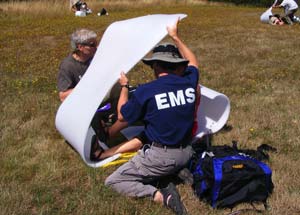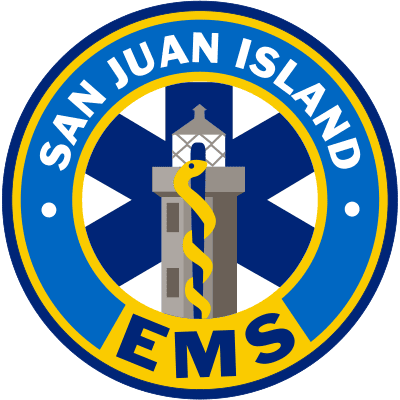Wilderness First Responder (WFR)
 The Wilderness First Responder curriculum uses the principles of long-term care, improvised resources, and varying environmental conditions as the framework for learning. Now the most widely recognized and most often required outdoor leader certification, the Wilderness First Responder course was first developed and taught by SOLO in the mid-1980’s. Created to provide outdoor leaders, guides, and rangers with the knowledge needed to deal with crises in remote settings, this 80-hour certification course meets DOT National Standards for First Responder with additional protocols for extended-care situations. Like all SOLO programs, the emphasis of the WFR is on prevention and decision-making.
The Wilderness First Responder curriculum uses the principles of long-term care, improvised resources, and varying environmental conditions as the framework for learning. Now the most widely recognized and most often required outdoor leader certification, the Wilderness First Responder course was first developed and taught by SOLO in the mid-1980’s. Created to provide outdoor leaders, guides, and rangers with the knowledge needed to deal with crises in remote settings, this 80-hour certification course meets DOT National Standards for First Responder with additional protocols for extended-care situations. Like all SOLO programs, the emphasis of the WFR is on prevention and decision-making.
The SOLO WFR addresses the issues of medicolegal concerns, bloodborne pathogens and infectious diseases. The Patient Assessment System, the foundation of the course, trains students to determine what is going on with backcountry patients. Other sessions provide instruction in traumatic situations as well as medical emergencies. Environmental issues such as hypothermia and heat injuries are dealt with in great detail. Practical simulations and labs provide practice in backcountry leadership and rescue skills.
Faqs
Who is the Course for?
The WFR is the perfect course for anyone working in a position of leadership in an outdoor setting or for individuals who want a high level of wilderness medical training for extended personal backcountry trips or expeditions.
How long is a WFR Course?
The intensive 80-hour curriculum takes place over either nine or ten days as established by the hosting organization. By the hosting group’s request, days off can be built into the schedule. A typical day consists of a mixture of hands-on practical skill work and didactic lecture sessions. To optimize learning potentials, SOLO complements these sessions with a variety of mock scenarios and simulations. The program is fast-paced and both intellectually and physically demanding.
What should I bring with me?
Since much of the class time is outdoors, SOLO asks that you come prepared for the time of year and environment in which you are taking the course. Sturdy boots, reliable raingear, and outdoor items such as hats, gloves, and headlamps are entirely appropriate. A gear list of required and recommended items will be sent to you with your registration confirmation.
About WFR Certification
Students who successfully complete the SOLO Wilderness First Responder course will receive a SOLO Wilderness First Responder card and an American Heart Association Adult Heartsaver CPR card (or equivalent).
Certification is based on successful completion of the course. In order to do so, all certification candidates are required to participate in 100% of the course, as that is the best way to assess mastery of the skills involved. SOLO instructors provide ongoing feedback and many opportunities for questions. Final assessment of each student’s skills includes written and practical exams.
Course Outline
Section 1: Introduction
- Introductions
- Staff, Students & Course Outline
- SOLO…A look at who we are
- Wilderness First Responder vs. Urban First Responder
- Role of the WFR
- Medicolegal issues
- Bloodborn pathogens & infectious disease
Section 2: Patient Assessment System (PAS)
- Patient Assessment System
- Anatomy of a Backcountry Crisis
- Primary Survey= “the first five minutes”
- Secondary survey & vital signs
- History Taking and AMPLE
- Lifting and moving techniques
- PAS in the extreme environment
Section 3: Rescues and the Human Animal
- Organizing the rescue= SOAP note and getting help
- The Ten Essentials
- Bivouac skills and practice
- The Human Animal – overview of the human physiology
- Body Systems – overview of human anatomy and physiology
Section 4: The Cardiovascular System
- The Anatomy and Physiology of the cardiovascular system
- Cardiopulmonary Resuscitation (CPR)
- Prudent Heart Living
- Techniques of CPR
- CPR Skills practice
Section 5: Cardiopulmonary Resuscitation
- CPR practical exam
- CPR considerations in the remote environment
- Automated External Defibrillation
Section 6: Soft Tissue Injury
- Shock & bleeding control
- Long term management of the shock victim
- The anatomy and physiology of the integumentrary system
- Soft tissue injuries & bandaging skill
- Long term wound care
- Burns
Section 7: The Musculoskeletal System
- The anatomy and physiology of the musculoskeletal system
- Sprains and strains
- Fractures & splinting techniques
- Dislocations and reduction techniques
- Splinting practice
Section 8: The Central Nervous System
- The anatomy and physiology of the central nervous system
- Head trauma
- Spinal cord injury
- Spinal cord management: Improvised collar, long boarding, litter packing
Section 9: The Chest and Abdominal Systems
- The anatomy and physiology of the respiratory system and cardiothoracic region
- Chest Trauma
- The anatomy and physiology of the gastrointestinal and genitourinary system
- Abdominal trauma
Section 10: The Human Animal & Environmental Emergencies Part I
- The Human Animal
- Heat related injuries – dehydration, heat exhaustion, heat cramps and heat stroke
- Cold related injuries – hypothermia, frostbite and non-freezing cold injuries
Section 11: Environmental Emergencies Part II
- Lightning related injuries
- Drowning related injuries
Section 12: Animals, Plants and Allergies
- Animals that bite and sting
- Plants that bite and sting
- Allergic reactions – local, systemic & anaphylactic
- Use of epinephrine
Section 13: Environemntal Emergencies Part III
- Altitude Related Injuries
- Medical Emergencies and Patient Assessment
Section14: Medical Emergenices Part I
- Changes in Level of Consciousness (LOC)
- Diabetic Emergencies
Section 15: Medical Emergencies Part II
- Chest pain
- Shortness of breath
- Emergency Childbirth
Section 16: Medical Emergencies Part III
- Poisoning
- Abdominal Pain
- Group Preventative Medicine
- Water purification
- Sanitation/Defication
Section 17: Long-term Patient Care
- Wilderness stabilization and bivouac
- Improvising litters
- Leadership in a backcountry emergency
Section 18: Mock Rescue
- Mock Rescue
- Debrief
Section 19: WFR Practical exam
- Practical exam
- Common expedition problems
Section 20: WFR Written Exam
- Written exam
- Closure and Graduation
